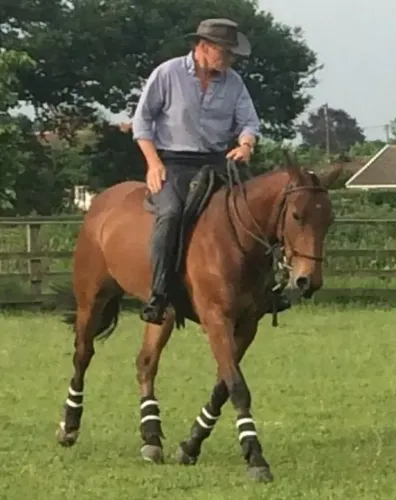
Table of Contents
The preamble
Over 50 years ago as a teenager, my grandfather always reminded me to run my hand down my horse's legs to look for heat. This is one of the best tips I received and to this day running my hand down the legs is a morning task for any horse in my care. The task is so simple and really important, so I wish to share the words of wisdom with all equestrians out there.
So why do I need to run my hand down my horse's lower leg?
A horse that has injured a lower limb will have detectable heat in the affected limb and this is caused by extra blood being pumped to the area to heal the damaged soft tissue. For this reason, the leg pulse will be stronger and quicker in the area and this means that you will be able to notice when your horse has a mild sprain or something more serious.
Understand your horse's body language and understand your horse!
Horses can not speak so we must use other ways to notice when things are out of place.
How do I run my hand down my horse's legs to look for heat?
Daily and in the morning run your hand down your horse’s legs below both knee and hock to look for a leg that is warmer than the others. Now hopefully, all legs will feel the same but if one appears warmer then there will be a problem. This is more likely in the front leg but could occur in the back leg.
Top tip!
Frequently when a horse injures himself in training this will be detected as heat in the limb in the following morning. Heat can be present without swelling and without lameness, so it is an early warning sign that must be looked into.
A few words of warning
- In the morning some horses can present with one cold and one warm front leg. On feeling the back legs it is clear that one front leg is much colder than the rest. I have found that this disappears when the horse starts to move. I have never found a satisfactory answer to this conundrum, but poor circulation or the way the horse has been lying down could be reasons.
- If you suspect a warmer leg and keep rubbing it you will make it warmer than the rest, so once or twice should suffice.
What do I do next if there is heat in my horse's leg?
In all cases, action must be taken so that the problem does not escalate. It is essential to find the seat of the problem so that you know what to do next. The three different situations associated with lower leg heat are listed here.
- No lameness at all.
- Low-grade spasmodic lameness.
- The horse could be obviously lame.
A horse with low-grade lameness needs rest and probably veterinary assistance. An obviously lame horse clearly needs rest and veterinary support. If the horse is not lame then prudent intervention often prevents problems from appearing. If in doubt about the significance of heat without lameness have a UTC scan.
What do I do if my horse has leg heat with no lameness or swelling?
In all cases reduce the work intensity until the heat is no longer present.
- If your horse's programme involves walking and trotting bring this back to walking.
- A programme involving trotting and cantering should be brought back to trotting and maybe walking.
- Jumping and galloping should be stopped.
Finally, when the heat has gone and the horse is healed, slowly re-introduce the horse’s training regime. This is the stage to be aware. If the heat returns the damaged tissue has not healed and your horse's training programme needs to be taken back to a more basic stage.
Using pain killers to keep a horse sound and in work is not recommended!
The horse will not feel pain but the soft tissue damage will not have healed.
The take-home message
Always regard heat in your horse's lower leg as serious. Remember that your horse is your silent partner who is unable to tell you that he has a problem, so it is down to you to keep him sound and well. Never “patch your horse up” by using painkillers so that he can be kept at work. Otherwise, his working life will be considerably shorter than it should be.

Article Suggestion
Free and Cheap Leg Coolants for your Horse
